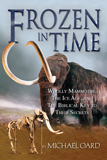
Mystery Mammoth Points to a Global Flood and Ice Age
According to a report recently published in The Washington Post,1 researchers have uncovered the cranial remains of an enigmatic mammoth. “I have seen a lot of mammoth skulls and this is one of the best preserved I have ever seen,” declared Don Morris, a retired archaeologist associated with the find. Discovered on Santa Rosa Island (one of the Channel Islands, approximately 106 miles from Los Angeles, California), it seems that this exceptional specimen has led to more questions than answers.
Something New?
The article states that the animal’s age at death, species, and relatedness to other varieties of mammoth are presently undetermined. The tusks of juvenile mammoths are short and mildly curved, while those of adults are typically long and coiled. This specimen features one of each tusk style—an unprecedented condition—the significance of which is still unknown. As the article points out, future dental studies may help us better pinpoint how old the animal was when it died.
Though the creature was clearly a mammoth (genus Mammuthus), a more specific identification is less certain. Given the location and level of deposition, the Columbian mammoth (M. columbi) or pygmy mammoth (M. exilis) would seem the most likely candidates—particularly the latter, since pygmy mammoths were native to the Channel Islands. However, the size of this new skull falls in between those of the other two species. There are currently about a dozen named species of mammoth. Hopefully, additional research will help determine if the Santa Rosa find represents an unusual expression of a currently described species or something truly new.
The Mammoth Tree
As is often the case, the Post article mixes in a little error with its truth. Mistaken information includes the provided absolute dates and the claim that pygmy mammoths “evolved” from Columbian mammoths.
As is often the case, the Post article mixes in a little error with its truth.
Taking the latter assertion first, it is quite possible that pygmy mammoths descended from Columbian mammoths due to insular dwarfism—this isn’t a problem in the biblical creationist model. The problem is what lies behind the Post’s use of the word “evolve.” When they selected the word “evolve,” it was doubtless intended to imply something more than simply one mammoth species originating from another. Instead, they almost certainly are implying that this particular instance of “evolution” is one twig on a single tree of transformation connecting all of biological life—neo-Darwinian evolution, or as some have described it, “goo to you.”
But God’s Word doesn’t allow for that possibility. Instead, it establishes that general animal types were created with distinct origins, that animals were uniquely created after their “kinds” (Genesis 1:21–25). The language implies unity and diversity on a couple of different levels. There is not only diversity in the form of distinct, separate, unrelated kinds, but there is also diversity within each kind, which we see expressed as various breeds, subspecies, species, etc. Rather than there existing a single biologic tree—absolute unity—or many rootless twigs of unchanging species, the biblical creationist model posits that God created a number of separate trees: distinct kinds.
So one may describe the derivation of pygmy mammoths from Columbian mammoths as a twig on a tree of transformation, but this mammoth tree—presently represented by living elephants—is only one tree in a grand orchard of many trees.
A Matter of Time
The Post article also claims that the new skull was discovered in a “13,000-year-old rock layer,” “Columbian mammoths . . . appeared in North America roughly 1 million years ago,” “the most recent ice age . . . started about 30,000 years ago,” and that there was a “previous glacial period about 120,000 years before that.”2
Aside from the fact that the Paleobiology Database assigns a date of 4.9 million years ago to the earliest North American remains of the Columbian mammoth, there is a more significant problem with the dating claims. When the Bible’s history (e.g. the genealogies in Genesis) is synchronized with other historical records, we find that all creation is around 6,000 years old. Since death exists as an earned paycheck for sin (Romans 6:23), introduced by Adam’s disobedience (Romans 5:12; Romans 8:19–22), all of these animals—the new mammoth, Columbian mammoths, and pygmy mammoths—must have died after the Fall of man. Therefore, the rock layer in which the skull was found, the appearance of Columbian mammoths, and all glacial periods are actually much younger than the article states.
Global Cooling
Is the idea of an “ice age” or “glacial periods” a farce—inexorable from popular evolutionary hypotheses and millions of years? It actually isn’t. In fact, biblical creationist models predict that an ice age is one likely consequence of the global Flood. Furthermore, the physical evidence for a post-Flood Ice Age is compelling.
The physical evidence for a post-Flood Ice Age is compelling.
The models predict that an Ice Age began shortly after the Flood and lasted for a maximum of several centuries. As water evaporated from the oceans and the glaciers advanced, sea levels fell, exposing land that was otherwise underwater. This newly exposed ground granted entry into areas that were previously inaccessible. As the Post article points out, it is possible that the pygmy mammoths descended from Columbian mammoths who made (what were at the time) short swims from the California mainland to a single landmass—one much larger than the island chain we see today. Toward the end of the Ice Age, melting glaciers caused the sea levels to once again rise, inundating the island’s valleys, and eventually trapping the mammoths on the remaining mountaintops. These mountaintops became what we know today as the Channel Islands.
The Human Touch
The Post further observes that a set of femurs called “Arlington Springs man” (“Arlington man” in the article), also discovered on Santa Rosa Island, was a contemporary of the newly discovered mammoth. Though a number of human-related objects from North America date earlier (e.g., a multi-purpose tool from Oregon, butchered bear bones in the Yukon, and human tracks in British Columbia), these bones are among the earliest-known human remains in North America. And while the absolute date of 11,000 BC is unreliable, the relative dates for the mammoth and human remains probably are reliable—meaning they likely did live at the same time.
On Wrangel Island off the coast of Russia, mammoths may have still been around when Joseph was vizier in Egypt. But this was not the case for the Channel Island mammoths, because they are absent in sediment conventionally dated 10,000 BC or later. Provided this information, it is reasonable to wonder if people had something to do with their disappearance. When the dates are revised to a more realistic chronology, the difference between “11,000 BC” and “10,000 BC” is more or less negligible—probably several decades at most. From “10,000 BC” to “9,000 BC,” Santa Rosa Island was a buzzing coastal settlement. There are curious crescent-shaped tools, large middens, and lots of red abalone shells, demonstrating that these people were likely proficient seafarers.
All things considered, especially bearing in mind the comparatively compressed timeline, the odds seem pretty high that the Channel Island mammoths were hunted to extinction. On the other hand, even if these animals died out through other means, it is important to remember that Adam’s sin remains at the root of it. In this way, even the skull of an extinct elephantid can remind us that one day the Last Adam (1 Corinthians 15:45–47), Jesus Christ, will crush the last enemy, death, under His feet (1 Corinthians 15:25–28).
Footnotes
- Sarah Kaplan, “This Little Mammoth Skull Raises Some Big Questions,” The Washington Post, September 19, 2016, https://www.washingtonpost.com/news/speaking-of-science/wp/2016/09/19/this-little-mammoth-skull-raises-some-big-questions/.
- Ibid.
Recommended Resources

Answers in Genesis is an apologetics ministry, dedicated to helping Christians defend their faith and proclaim the good news of Jesus Christ.
- Customer Service 800.778.3390
- © 2024 Answers in Genesis





